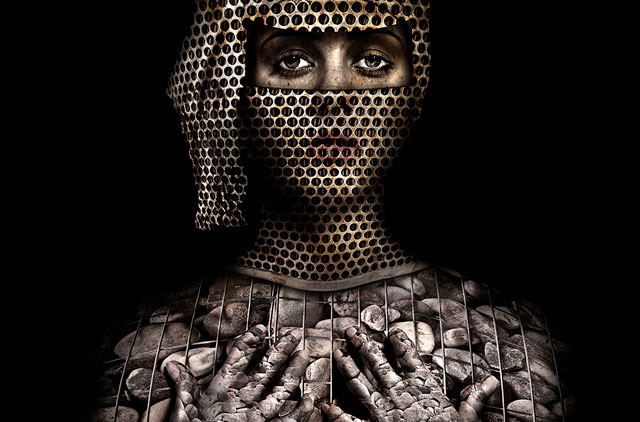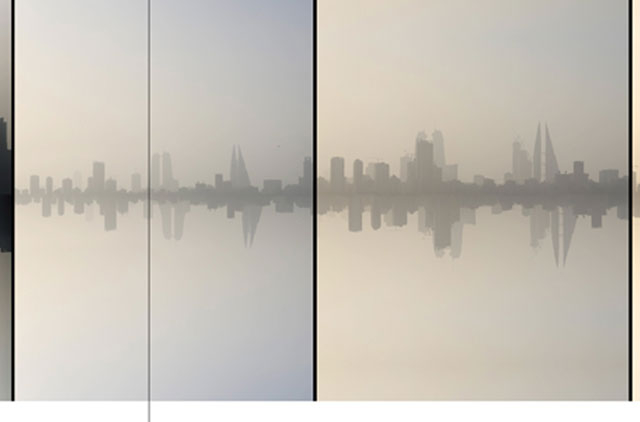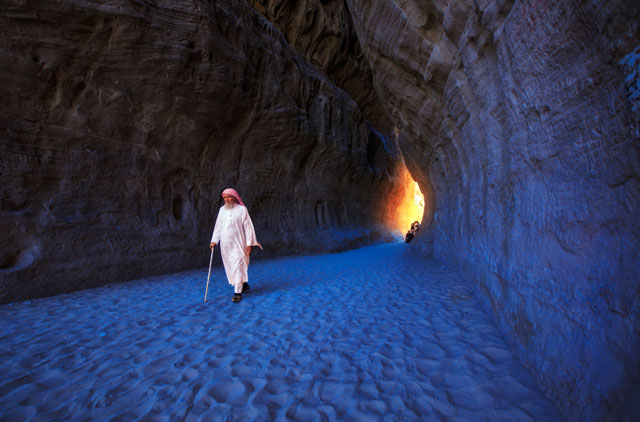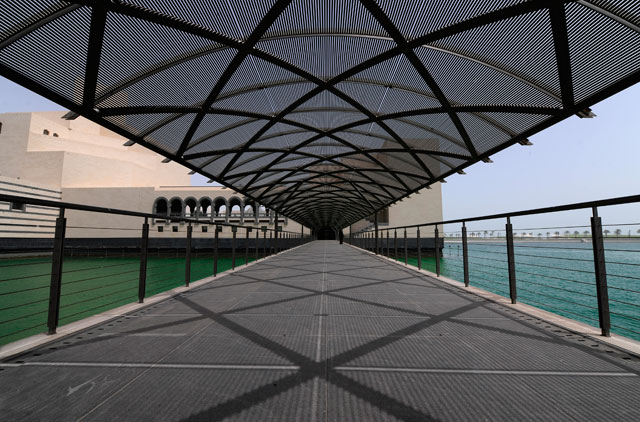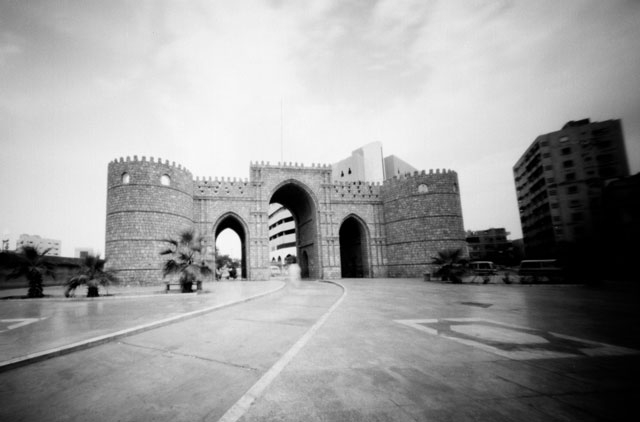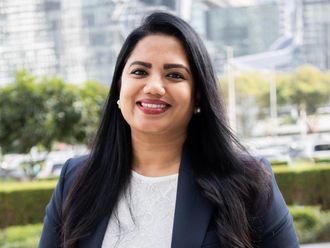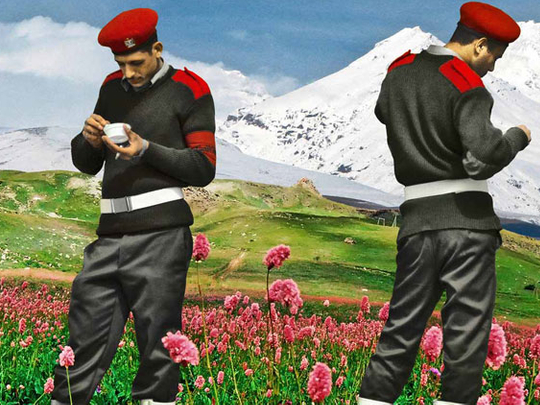
The Arab world is changing, whether driven by a political revolution, ideological shifts or cultural emancipation. GN Focus explores this new world through the lens of some of the finest Arab photographers, based in the region and abroad. Whether inspired by the geography, Arab Spring or architecture, these works of art push the boundaries of photography, art and technique, in the process shattering stereotypes and presenting powerful visuals of a new world.
Nermine Hammam
A Cairo-based visual artist creating densely composed figurative prints that occupy the space between painting and photography.
The perspective: January 2011, at the onset of the Arab Spring, Hammam was in Tahrir Square, Cairo, when army tanks rolled in to quash the growing rebellion. She diligently captured the turmoil of the Arab Spring as it spread across Egypt. Not content with merely capturing the action on the streets of Cairo, she placed the real images incongruously against utopian postcard scenes from nature — mountains, flowers and green fields or backdrops modelled on stylised landscapes of traditional Japanese screens — imbuing her work with a fresh perspective. Her goal was to “conjure harmony and hope,” she says.
The work: Soldiers eating ice cream is from Hammam’s Uppekha series. The series’ name is derived from the Buddhist concept of equanimity. Hammam breaks the myth of the all-powerful army and addresses stereotypes of military power. She humanises these soldiers by superimposing their photograph on a kitsch background with bright colours. Like postcards, she transports these young men to peaceful settings that are falsely naive, and sometimes dreamlike.
Ayman Lotfy
A Cairo-based artist and designer and the Middle East Regional Director of the Photographic Society of America, Lofty seamlessly combines fine art and video art installations with photography.
The perspective: For Lotfy, photography has the same language, rules, emotions and guidelines the world over. “What makes us different is our creativity. I believe that we Middle Eastern people have a powerful way of expressing our emotions. In the last three years, the changes in our political realm have led us to become more creative in order to explain our disapproval through art, not through violent upheaval.”
The work: The lady in the gas mask is from Lotfy’s latest series The Hidden, which explores the hurt and abuse inflicted upon women in the name of jihad. It is about acknowledging the women who are hidden from the world because to not do so would be to lose them for ever, making them almost obsolete — “out of sight, out of our world, out of our reality,” Lotfy says.
Steve Sabella
A Berlin-based Palestinian artist who uses photography and photographic installation as his principal modes of expression.
The perspective: “The Middle East manages to put artists in a constant state of visual alert. There is endless information and history to be revealed and photography allows us to access them in a unique way,” explains Sabella. He believes that photographers should unlock another visual path towards our understanding of life and the world we live in. Believing that photographers in the region need to explore the medium and art further, Sabella says, “Photography in the Arab world has become earth bound for obvious reasons. That is, it deals to a large extent with the realities on the ground.”
The work: Sinopia is a body of four photo-collages on Bahrain. When The Bahrain National Museum commissioned 11 photographers from the Arab world to interpret Bahrain, Sabella accepted the visual challenge of trying to understand the country through its image. “As I moved through Bahrain I saw the skyline from different viewpoints and perspectives, and after a while, I started seeing a repeating rhythm. When I put my images together, an obvious sound frequency emerged. I commissioned a musical group, The Khoury Project, to create a composition based on the skyline. It was very intriguing to hear the secret sounds of the city. Every city has a skyline and I am now working on creating the visual sound of many cities,” he says.
Abdulmajeed Al Juhani
An amateur photographer from Saudi Arabia. The 29-year-old mechanical engineer is a self-taught photographer, who got hooked on his camera seven years ago and has since spared no efforts in perfecting his art.
The perspective: The timelessness of a photograph is what appeals to Al Juhani. “I like the idea of my pictures being around forever, and each time I remember this, it encourages me to take better pictures.”
The work: If a picture being preserved for posterity is a key motivator, the inspiration is the rugged ageless landscape of Saudi Arabia. A self-proclaimed landscape photographer, for Al Juhani, a lot of the distinct Arab aesthetic is influenced by the topography of the region. “I find that Arab photographers bring a new perspective to the medium by utilising their harsh natural surroundings to came up with amazing images,” he says.
Mahmoud Al Achi
The Doha-born Lebanese photographer and digital artist focuses on life in the Gulf and displays a preference for long-exposure night photography, light painting, and creating abstract images through photography-based digital art.
The perspective: For Al Achi the geography of the region is its biggest challenge. Harsh arid summers make stepping out and taking photographs almost impossible, leaving a brief window of a few months a year in which to explore the surroundings. He believes that the Arabic aesthetic draws on geography and religion. “Arabic architecture and art often feature geometric repetition, finding a place in the photography of the region too. A lot of photographers here like to take pictures of architectural details.”
The work: Entitled My Identity, the image is of the iconic Museum of Islamic Art in Doha. Al Achi approaches the shot from a different angle to tourist shots. “We are led to this beautiful building via an ordinary object, a walkway, which despite its ordinariness, creates an aesthetically appealing image; notably from the geometric patterns formed by the struts on the cover of the walkway and shadows cast by them,” he says.
Wed Abduljawad
A California-based Saudi Arabian photographer who participated in My Father’s House, a large-scale, lens-based project that toured the Middle East from 2009 to 2010.
The perspective: Abduljawad believes there is still a lot more for the world to see when it comes to this region. She feels that the Arab world is not captured adequately in photographs or represented accurately, mainly due to a lack of access. “People are not given full access to documents and traditional opinions about being exposed to the camera still exist. Governments and people limit access and restrict photography,” she says.
The work: “My outlook is focused on preserving our heritage rather than focusing on the modern,” says Abduljawad. Using architecture as a focal point to explore the role and value of cultural heritage in defining cultural identity, she believes it is important to know your roots in order to move forwards — an important message in a rapidly changing region. This image is of Gold Street in Al Balad, Jeddah, and was captured on film using a handmade pinhole camera.


